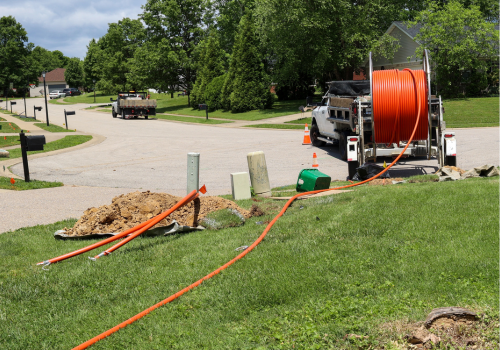1. Utility mapping with the help of GIS, Sensors and AI
According to the Common Ground Alliance, accidental damage to buried utility infrastructure cost an estimated $30 billion each year. Accurate mapping of utility assets can help prevent accidents and damage to infrastructure as well as costly overruns and project delays. New innovative technologies are transforming utility maps into powerful tools.
Through geospatial information systems (GIS) utility maps are digitized, making them easier to access in the field and across an organization. When combined with advanced sensors and monitoring systems, GIS systems can provide utilities with location, condition and connectivity information on their assets in real time. When leaks and other issues are detected and addressed sooner, it can often reduce the need for more major repairs. With artificial-intelligence (AI) the vast amount of data collected from sensors and other sources can be used to predict failures and optimize asset management and maintenance scheduling.
AI can also help improve system reliability with inspections of above-ground assets. FirstEnergy and its electric companies have been exploring the use of AI-powered cameras to evaluate the condition of light poles. In in pilot program conducted in 2022, a three-camera system, mounted on inspection trucks identified damage to poles and components, AI flagged 1,646 cross arms for further inspection, picking up 89% of the defects that human inspectors found in the field.
2. Autonomous robots for pipe inspection
The non-profit Dig Deep estimates that 2.22 million people in the U.S. are without running water and basic indoor plumbing. With so many people facing a water shortage, utilities can’t afford to have leaky pipes. Autonomous robots empowered by artificial intelligence (AI), 5G and big data offer new hope to make pipeline inspection more cost-effective and less dangerous.
Now in field testing, autonomous robots can autonomously navigate and document the condition of drinking water pipes without disrupting operations. French manufacturer, Acwa Robotics, earned a CES2023 Innovation Award for its Clear Water Pathfinder, a snake-like robot capable of moving through elbows, and service lines, with or against the flow of water in a respective pipeline. Each Pathfinder robot is equipped with sensors that are adapted to the pipeline material, diameter, and network operational model. The company hopes that eventually, robots will be working permanently inside the pipes, and capable of not only identifying issues, but making repairs.
One of the biggest advantages autonomous robots offer over tethered robots, which are the most common pipe robots on the market today, is 24/7 pipe monitoring without putting anyone in harm’s way.
Researchers at the University of Sheffield have also developed fully autonomous, micro, pipe crawling robots. At a width of just 40mm,Pipebots are tiny robots equipped with all-terrain legs and cameras for eyes. Pipebots move autonomously and will use onboard sensors to scan for faults and repair them. With failure free operation, the goal is to end unnecessary and costly unplanned road excavation. ‘
It’s not only water pipes where autonomous robots will have an impact. Oil and gas pipelines are another opportunity due to an increasing number of severe accidents caused by damaged pipelines. University of Houston researchers are developing an autonomous robot to identify potential pipeline leaks and structural failures during subsea inspections. The technology will make the inspection process safer and more cost-effective, while protecting subsea environments from disaster.
3. Lithium alternatives
Lithium batteries are not environmentally friendly and meeting increasing demand for lithium will be a challenge with current supply. This has manufacturers and utilities looking for alternative battery materials to power the next generation of battery storage. One of the most viable alternatives are zinc-air batteries, given zinc’s abundant supply, inherent stability, and low toxicity.
Earlier this year, the U.S. Department of Energy’s (DOE)Loan Programs Office made a conditional commitment to Eos Energy Enterprises, Inc. for a $398.6 million loan guarantee for the construction of up to four state-of-the-art production lines to produce the “Eos Z3,” a next-generation utility- and industrial-scale zinc-bromine battery energy storage systems in Turtle Creek, Pennsylvania.
Eos’s zinc-bromine Eos Z3 batteries provide alternative battery chemistry to lithium-ion, lead-acid, sodium-sulfur, and vanadium redox chemistries for stationary battery storage applications. Eos’s technology is designed for long-duration grid-scale stationary battery storage that can assist in meeting the energy grids’ growing demand with increasing amounts of renewable energy penetration. Eos batteries are non-flammable and do not require active cooling to operate. The project is expected to manufacture 8 GWh of storage capacity annually by 2026 – enough to provide electricity to over 300,000 average U.S. homes instantaneously.
Another promising lithium alternative is sodium-sulfur batteries. An international research team working at the University of Sydney and Chongqing University recently fabricated a room-temperature sodium-sulfur (Na-S) battery to provide a high-performing solution for large renewable energy storage systems. Researchers say the sodium battery has the potential to dramatically reduce costs while providing four times as much storage as lithium batteries.
Sodium-sulfur batteries have a high potential for grid-scale stationary energy storage, due to their low cost and high theoretical energy density of both sodium and sulfur. However, they have also been seen as an inferior alternative and their widespread use has been limited by low energy capacity and short life cycles.
4. Hydrogen-powered construction equipment and heavy trucks
For construction machines which require a lot of power, OEMs are increasingly turning to hydrogen fuel cells. In May, 2023, Komatsu introduced a concept machine for a medium-sized hydraulic excavator that combines a hydrogen fuel cell and Komatsu-developed key components to achieve carbon neutrality. The company plans to accelerate commercial production for medium and large-construction equipment.
In May, Hyundai Motor Company premiered its new XCIENT Fuel Cell tractor, the commercialized class 8 6x4 fuel cell electric model, for the North American commercial vehicle market. First launched in 2020, XCIENT Fuel Cell has already been deployed in five countries, including Switzerland, Germany, Israel, Korea and New Zealand. A 6x4 tractor equipped with two 90 kW hydrogen fuel cell systems (total 180 kW power) and a 350 kW e-motor has a gross combination weight maximum of 82,000 pounds and offers a driving range of over 450 miles per charge even when fully loaded.
Accelera, by Cummins, has a fuel cell engine with improved power density, efficiency and durability while delivering zero greenhouse gas and zero criteria air emissions. It is available in single 150 kW and dual 300 kW module engines for heavy-duty off-highway applications.
Unlike hydrogen fuel cells, which use a chemical process to convert hydrogen into electricity, JCB is investing in hydrogen combustion engines which burn hydrogen, producing power through combustion. Prototype JCB hydrogen engines have already powered a backhoe loader and Loadall telescopic handler machines. JCB believes that for now, fuel cells are too expensive, too complicated and not robust enough for construction and agricultural equipment.
Caterpillar recently launched a three-year program to demonstrate an advanced hydrogen-hybrid power solution built on its new Cat C13D engine platform. Caterpillar’s six-cylinder Cat C13D enables the use of renewable liquid fuels such as 100% HVO, B100 Distilled Biodiesel, and even up to B100 Standard Biodiesel by working with the local Cat dealer*. In addition to using hydrogen, its core architecture is designed for the future development of spark-ignited natural-gas capabilities. Available for early OEM pilots in 2025 and scheduled for production in 2026, the Cat C13D engine is targeted for a wide range of off-highway equipment, including rock crushers, screeners, and grinders; trenchers; agriculture tractors, harvesters, self-propelled sprayers and woodchippers; material-handling equipment; and large industrial pumps.
5. New tech for methane leak detection
The U.S. Environmental Protection Agency is taking aim at methane gas with revised monitoring requirements for fugitive emissions and operational performance requirements for flares and other control devices. To help the industry meet reduce methane emissions, the Department of Energy’s Office of Fossil Energy and Carbon Management (FECM) recently provided $42 million in funding toward the research and development of new monitoring, measurement, and mitigation technologies to help detect, quantify, and reduce methane emissions across the United States. Existing methane monitoring devices have limited ability to cost-effectively, consistently, and precisely locate and quantify the rate of methane emissions. Affordable sensing systems would enable more effective methane mitigation programs, which could lead to a reduction in overall methane emissions and more efficient extraction and use of domestic energy resources.
The Advanced Research Projects Agency–Energy (ARPA-E), is supporting several technologies for methane detection as part of its SCALEUP program. Bridger Photonics is a mobile methane sensing system capable of surveying a 10 meter by 10 meter well platform in just over five minutes with precision that exceeds existing technologies used for large-scale monitoring. Bridger’s light-detection and ranging (LiDAR) remote sensing system will use a novel, near-infrared fiber laser amplifier in a system mounted on a ground vehicle or an unmanned aerial vehicle (UAV), which can be programmed to survey multiple well pads per day. Data captured by the LiDAR system will provide 3-D topographic and methane absorption imagery using integrated inertial navigation and global positioning system data to show precisely where a methane leak may be occurring and at what rate. Bridger Photonics recently raised $55 million in funding from Beaverhead Partners, a syndicate composed of Madison Valley Partners, Carica Sustainable Investments, and Next Frontier Capital. T
Colorado State University (CSU) and Caterpillar will develop technology to reduce methane emissions from lean-burn natural gas engines by reducing methane ventilation through the crankcase, the engine
Southwest Research Institute (SwRI), with support from National Energy Technology Lab, developed a novel methane leak detection technology that has the potential to significantly reduce greenhouse gas emissions in the energy sector, targeting compressor stations. SwRI’s Smart Methane Emission Detection System (SLED/M) can reliably, accurately, and autonomously detect and estimate methane leaks in real time using midrange infrared (MWIR) optical gas imaging (OGI) cameras. The technology represents a significant improvement over existing methane detection systems, which have significantly lower estimation capabilities.
Pressing problems such as rising greenhouse gases and workplace accidents from underground construction have become the catalyst for several new technology trends. Add in government incentives and these technology advances are likely to come to market sooner than you think. Utility firms should prepare by learning how these new technologies are being deployed in the field.
Subscribe to The Utility Expo monthly newsletter to receive more industry insights like this.
Read Next
Technology and Labor Trends Impacting the Utility Industry
Top Tech Trends for Utilities in 2023
AI is Ready to Take a Leading Role in Improving Utility Fleet Management












